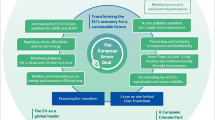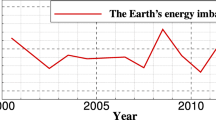Abstract
Since the end of the 1990s, international energy experts have stressed the increasing strategic importance of energy supply security as part and within the ‘energy triangle’ with its three major objectives: economic competitiveness, environmental/climate sustainability and energy supply security. In the view of many energy security experts, the biggest challenge is seen in maintaining the balance between the three objectives instead of favouring one at the expense of the other two. The following analysis addresses this ‘puzzle’ of the energy triangle and compares the interrelated energy security-climate change mitigation nexus between the USA and the EU: how both sides manage the contradictions and, more specifically, how do the two transatlantic partners attempt to achieve the needed balance within the energy triangle and its three objectives?
Similar content being viewed by others
Notes
See International Energy Agency (IEA), Energy Security and Climate Policy. Assessing Interactions (Paris: IEA, 2007), 18, 102 ff.
Quoted by F. Umbach, ‘Global Energy Supply and Geopolitical Challenges’, in Asia and Europe. Cooperating for Energy Security. Council for Asia-Europe Cooperation, ed. F. Godement, F. Nicolas, and T. Yakushiji (Paris: Centre Asie IFRI, 2004), 137–68 (142).
So the definition of ‘energy security’ by the IEA: https://doi.org/www.iea.org/subjectqueries/keyresult.asp?KEYWORD_ID=4103.
See also A. Löschel, U. Moslener, and D.T.G. Rübbelke, ‘Indicators of Energy Security in Industrial Countries’, Energy Policy 38 (2010): 1665–71
Löschel, Moslener, and Rübbelke, ‘Editorial: Energy Security — Concepts and Indicators’, Energy Policy 38 (2010): 1607–8
Andy Stirling, ‘Multicriteria Diversity Analysis: A Novel Heuristic Framework for Appraising Energy Portfolios’, Energy Policy 38 (2010): 1622–34
and D. von Hippel et al., ‘Energy Security and Sustainability in Northeast Asia’, Energy Policy 39 (2011): 6719–30.
See F Umbach, ‘Energy Security in Eurasia: Clashing Interests’, in Russian Energy Security and Foreign Policy, ed. Adrian Dellecker and Thomas Gomart (Abingdon and New York: Routledge, 2011), 23–38 (25 f).
See the present definition of ‘energy security’ by the IEA — https://doi.org/www.iea.org/topics/energysecurity/ (accessed June 3, 2012).
The following analysis is based on an revised and updated version of my previous publication — F. Umbach, ‘The EU and Germany’s Policies on Climate Change’, in Global Warming and Climate Change. Prospects and Policies in Asia and Europe, ed. Antonio Marquina (Basingstoke, Hampshire, and New York: Palgrave-MacMillan, 2010), 227–52.
See IEA, World Energy Outlook (WEO) 2011 (Paris: IEA/OECD, 2011), 99 ff and 205 ff
The IEA’s ‘New Policy Scenario’ includes recent government policy commitments to be implemented in a cautious way, even when they are not yet backed by companies’ strategies. But the scenario is also based on the assumption and needs to expand nuclear power worldwide and even in the OECD countries as well as CCS as a key abatement option, accounting for 18% of emissions savings in the more ambitious 450 Scenario, relative to the New Policy Scenario. But both assumptions have become uncertain due to the nuclear catastrophe of Fukushima in March 2011 and many regulatory, technical and political obstacles for the CCS-technology implementation — see IEA, WEO 2011 (Paris: IFRI/OECD, 2011).
See IEA, WEO 2007: China and India Insights (Paris: IEA, 2007), 192 ff.
National Research Council of the United States, Advancing the Science of Climate Change (Washington, DC: The National Academies Press, 2010).
See also Jeffrey Mazo, Climate Conflict. How Global Warming Threatens Security and What to Do About It (Abingdon and Paris: Routledge/IISS, 2010).
See D. Yergin, ‘Ensuring Energy Security’, Foreign Affairs 85, no. 2 (March-April 2006): 69–82 (74).
See J. Mouawad, ‘Promise of Biofuel Clouded by Weather Risks’, New York Times, July 1, 2008, https://doi.org/www.nytimes.com/2008/07/01/business/01weather.html?pagewanted=all&_r=0(accessed July 2, 2008).
Richard A. Betts et al., ‘When Could Global Warming Reach 4°C?’, Philosophical Transactions of the Royal Society 369, no. 1934 (January 2011), 67–84.
See N. Stern, The Stern Review: The Economics of Climate Change (London: HM Treasury, 2006). But a new report by the Global Warming Policy Foundation —
Peter Lilley, What is Wrong with Stern? The Failings of the Stern Report of the Economics of Climate Change (London: Global Warming Policy Foundation, 2012) — has cast grave doubts on the economic validity of the Stern report which many governments relied on to justify their climate mitigation policies.
See also Daniel Yergin, ‘America’s New Energy Security’, The Wall Street Journal (December 12, 2011), https://doi.org/online.wsj.com/article/SB10001424052970204449804577068932026951376.html (accessed December 15, 2011).
See Edward Morse et al., Energy 2020. North America, the New Middle East (New York: Citigroup, 2012).
See EIA, Annual Energy Outlook (AEO) 2012 Early Release Overview (Washington, DC: EIA, 2012).
See Ibid., 8.
See White House, The Blueprint for a Secure Energy Future: Progress Report (Washington, DC: White House, March 2012).
‘Obama’s Remarks on Oil and Gas Subsidies, March 2012’, Council on Foreign Relations, New York, March 29, 2012.
See M. Kuhn and F. Umbach, Strategic Perspectives of Unconventional Gas in Europe: A Game Changer with Implications for the EU’s Common Energy Security Policies, EUCERS-Strategy Papers, Vol. 1, No. 1, London, May 2011
and Kuhn and Umbach, ‘Unconventional Gas Resources: A Transatlantic Shale Alliance?’, in Transatlantic Energy Futures. Strategic Perspectives on Energy Security Climate Change and New Technologies in Europe and the United States (Washington, DC: Center for Transatlantic Relations, Paul H. Nitze School of Advanced International Studies, John Hopkins University, 2011), 207–28.
IEA, Are We Entering a Golden Age of Gas? Special Report. World Energy Outlook 2011 (Paris: IEA, 2011).
See EIA, Annual Energy Outlook (AEO) 2012 Early Release Overview (Washington, DC, January 23, 2012), 1–2, https://doi.org/www.eia.gov/forecasts/aeo/er/early_production.cfm(accessed February 20, 2012).
See Guy Chazan, ‘Shale Gas Boom Helps Slash US Emissions’, Financial Times (FT), May 23, 2012.
Quoted following Fiona Harvey, ‘Gas Rebranded as Green Energy by EU’, The Guardian, May 29, 2012.
See also Henry Jacoby, ‘The Influence of Shale Gas on U.S. Energy and Environmental Policy’, Journal of Economics of Energy and Environmental Policy 1, no. 1 (2012): 37–51
and Vicki Ekstrom, A Shale Gas Revolution? MIT, January 3, 2012, https://doi.org/web.mit.edu/newsoffice/2012/shale-gas-revolution-report.html (accessed March 20, 2012).
See EIA, AEO 2012 Early Release Overview, 6.
Rick Piltz, ‘US Climate Policy’, March 18, 2012 (lecture, George Washington University, Elliott School of International Affairs, February 22, 2012), https://doi.org/www.climatesciencewatch.org/2012/03/18/us-climate-policy-lecture-at-gwu-february-2012/ (accessed June 6, 2012).
See P. Schwartz and D. Randall, An Abrupt Climate Change Scenario and Its Implications for United States National Security (Washington, DC: GBN for the Department of Defense, October 2003).
See J. Podesta and P. Ogden, Global Warning. The Security Challenges of Climate Change (Washington, DC: Center for American Progress, November 2007)
and K.M. Campbell, A.T.J. Lennon, and J. Smith, The Age of Consequences. The Foreign Policy and National Security Implications of Global Climate Change (Washington, DC: CSIS and Center for a New American Security, November 2007).
See Center for Naval Analysis (CAN), National Security and the Threat of Climate Change (Alexandria/Virginia: CNA-Corporation, 2007).
See also N Elhefnawy, ‘The Impending Oil Shock’, Survival 50, no. 2 (April-May 2008): 37–66
and F. Umbach, ‘Global Energy Security and the Implications for the EU’, Energy Policy 38, no. 3 (March 2010): 1229–40.
See High Representative/European Commission, Climate Change and International Security (Brussels: European Commission, 14 March 2008), S113/08.
See European Council, Presidency Conclusions (Brussels: European Council, 8–9 March 2007).
See European Commission, An Energy Policy for Europe (Brussels: European Commission, 10 January 2007), COM(2007) 1 final, 13.
See European Commission, Report on the Green Paper on Energy. Four Years of European Initiatives (Brussels and Luxembourg: European Commission, 2005).
See E. Rosenthal, ‘Europe Turns to Coal Again, Raising Alarms on Climate’, The New York Times, April 23, 2008, https://doi.org/www.nytimes.com/2008/04/23/world/europe/23coal.html?pagewanted=all (accessed April 27, 2008).
See F.; Umbach, The Future of Coal, Clean Coal Technologies and CCS in the EU and Central East European Countries: Strategic Challenges and Perspectives, EUCERS-Strategy Paper, vol. 2, no. 1, 12 December 2011.
See IEA, WEO 2011, 561 ff.; and the share of nuclear power in the overall EU energy mix will be maintained by 14% in 2009 till 2035 (New Policy Scenario) and increased up to 18% (450 Scenario) in 2035; the nuclear share in EU electricity generation will be reduced from 28% in 2009 to 23% (New Policy Scenario) or rise up to 31% (450 Scenario) in 2035.
See also F. Umbach, ‘Germany’s Non-Nuclear Strategy Risks Europe Electricity Supply’, Part III, Special Report, Geopolitical Information Service (GIS), January 18, 2012, 4, https://doi.org/www.geopolitical-info.com (accessed January 19, 2012).
See ‘State of Renewable Energies in Europe — EurObserv’ER’, European Energy Review, February 15, 2012.
See Mure Dickie et al., ‘Japan Cries Foul Over Rare Earths’, FinancialTimes.com, October 24, 2010; and Harald Elsner, ‘Kritische Versorgungslage mit schweren Seltenen Erden - Entwicklung “Grüner Technologien” gefährdet?’, Commodity Top News, ed. the Federal Institute for Geosciences and Natural Resources/BGR-German Raw Material Agency/ DERA, no. 36 (Hannover: BGR/DERA, September 2011), https://doi.org/www.bgr.bund.de/DE/Gemeinsames/Produkte/Downloads/Commodity_Top_News/Rohstoffwirtschaft/36_kritische-versorgungslage.pdf?blob=publicationFile&v=4 (accessed October 20, 2011).
See also Thomas Spencer, Anna Korppoo, and Agata Hinc, Can the EU Budget Support Climate Policy in Central and Eastern Europe, FIIA-Working Paper No. 70 (Helsinki: Finnish Institute of International Affairs, April 2011)
see also Andrew MacKillop, ‘Europe’s Green Energy Chaos’, European Energy Review, October 31, 2011
and Sonja van Renssen, ‘Ready... Set... Go! The European Decarbonisation Race is On’, European Energy Review, December 5, 2011.
See Alex Forbes, ‘Depressing... Disappointing... Bad News’. ‘Fatih Birol’s Sombre Perspective on our Energy Future’, European Energy Review, November 14, 2011, 3.
See Pilita Clark, Jan Cienski, and Joshua Chaffin, ‘Poland Blocks Brussels’ Efforts on Emission Targets’, Financial Times (FT), July 18, 2011.
See European Commission, Impact Assessment. Document Accompanying the Package of Implementation Measures for the EUs Objectives on Climate Change and Renewable Energy for 2020. Commission Staff Working Document, Brussels, SEC(2008) 85/3, 23 January 2008, 18.
See Karel Beckmann, ‘Replace Emission Trading Scheme with a Carbon Tax’, European Energy Review, May 10, 2012
Sonja van Renssen, The Fate of the EU Carbon Market Hangs in the Balance, European Energy Review, April 12, 2012
and Andreas Walstad, ‘Why the EU-ETS Will Never Work. Interview with Dieter Helm’, Natural Gas Daily, May 25, 2012, 4.
Author information
Authors and Affiliations
Corresponding author
Additional information
Notes on contributor
Frank Umbach is an Associate Director at the European Centre for Energy and Resource Security, King’s College, London; Senior Associate at the Centre for European Security Strategies, Munich and Non-Resident Senior Fellow at the European Centre for Energy and Resource Security, King’s College, London; Senior Associate at the Centre for European Security Strategies, Munich and Non-Resident Senior Fellow at the US Atlantic Council, Washington, DC. He is an expert on energy supply security and foreign relation issues in Russia, the Caspian Sea region, East Asia, NATO and the EU He has published several books, including Globale Energiesicherheit. Strategische Herausforderungen für die europäische und deutsche Außenpolitik (2003) and numerous articles in international scientific journals.
Rights and permissions
About this article
Cite this article
Umbach, F. The intersection of climate protection policies and energy security. J Transatl Stud 10, 374–387 (2012). https://doi.org/10.1080/14794012.2012.734672
Published:
Issue Date:
DOI: https://doi.org/10.1080/14794012.2012.734672




